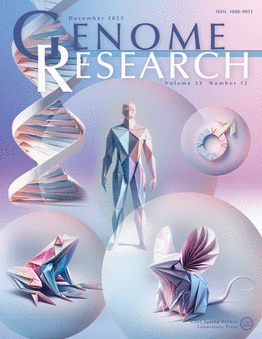Long-read RNA sequencing reveals allele-specific N6-methyladenosine modifications
IF 6.2
2区 生物学
Q1 BIOCHEMISTRY & MOLECULAR BIOLOGY
引用次数: 0
Abstract
Long-read sequencing technology enables highly accurate detection of allele-specific RNA expression, providing insights into the effects of genetic variation on splicing and RNA abundance. Furthermore, the ability to directly sequence RNA using the Oxford Nanopore technology promises the detection of RNA modifications in tandem with ascertaining the allelic origin of each molecule. Here, we leverage these advantages to determine allele-biased patterns of N6-methyladenosine (m6A) modifications in native mRNA. We utilized human and mouse cells with known genetic variants to assign allelic origin of each mRNA molecule combined with a supervised machine learning model to detect read-level m6A modification ratios. Our analyses revealed the importance of sequences adjacent to the DRACH-motif in determining m6A deposition, in addition to allelic differences that directly alter the motif. Moreover, we discovered allele-specific m6A modification (ASM) events with no genetic variants in close proximity to the differentially modified nucleotide, demonstrating the unique advantage of using long reads and surpassing the capabilities of antibody-based short-read approaches. This technological advancement promises to advance our understanding of the role of genetics in determining mRNA modifications.长读RNA测序揭示等位基因特异性N6-甲基腺苷修饰
长读测序技术能够高度准确地检测等位基因特异性 RNA 的表达,从而深入了解基因变异对剪接和 RNA 丰度的影响。此外,利用牛津纳米孔技术直接对 RNA 进行测序的能力有望在检测 RNA 修饰的同时确定每个分子的等位基因来源。在这里,我们利用这些优势来确定原生 mRNA 中 N6-甲基腺苷(m6A)修饰的等位基因偏倚模式。我们利用已知基因变异的人类和小鼠细胞来确定每个 mRNA 分子的等位基因来源,并结合监督机器学习模型来检测读数级 m6A 修饰比率。我们的分析表明,除了等位基因差异会直接改变Motif外,邻近DRACH-motif的序列在决定m6A沉积方面也很重要。此外,我们还发现了等位基因特异性 m6A 修饰(ASM)事件,这些事件与不同修饰的核苷酸之间没有任何基因变异,这证明了使用长读数的独特优势,并超越了基于抗体的短读数方法的能力。这一技术进步有望推进我们对遗传学在决定 mRNA 修饰中的作用的理解。
本文章由计算机程序翻译,如有差异,请以英文原文为准。
求助全文
约1分钟内获得全文
求助全文
来源期刊

Genome research
生物-生化与分子生物学
CiteScore
12.40
自引率
1.40%
发文量
140
审稿时长
6 months
期刊介绍:
Launched in 1995, Genome Research is an international, continuously published, peer-reviewed journal that focuses on research that provides novel insights into the genome biology of all organisms, including advances in genomic medicine.
Among the topics considered by the journal are genome structure and function, comparative genomics, molecular evolution, genome-scale quantitative and population genetics, proteomics, epigenomics, and systems biology. The journal also features exciting gene discoveries and reports of cutting-edge computational biology and high-throughput methodologies.
New data in these areas are published as research papers, or methods and resource reports that provide novel information on technologies or tools that will be of interest to a broad readership. Complete data sets are presented electronically on the journal''s web site where appropriate. The journal also provides Reviews, Perspectives, and Insight/Outlook articles, which present commentary on the latest advances published both here and elsewhere, placing such progress in its broader biological context.
 求助内容:
求助内容: 应助结果提醒方式:
应助结果提醒方式:


